#josé quaglio
Explore tagged Tumblr posts
Text
28 febbraio … ricordiamo …
28 febbraio … ricordiamo … #semprevivineiricordi #nomidaricordare #personaggiimportanti #perfettamentechic
2023: Yvonne Constant, attrice, cantante e ballerina francese. Dopo gli esordi come ballerina classica, Yvonne Constant orientò la sua carriera verso il cinema, in cui debuttò nel 1953, e la commedia musicale. La carriera di Constant si è estesa al cinema e alla televisione. Nel 1958 fece il suo debutto a Broadway nella rivista La Plume de Ma Tante. (n. 1930) 2023: Adriana Ambesi, nota anche con…

View On WordPress
#28 febbraio#Adriana Ambesi#Anna Sophie Ondráková#Annie Girardot#Anny Ondra#Cecil Kellaway#Christine Kaufmann#Christine Maria Kaufmann#Enrico Maria Salerno#Enrico Salerno#George Harris Kennedy#George Kennedy#Giuseppe Ferdinando Quaglio#Joan Greenwood#José Quaglio#Leone Di Lernia#morti 28 febbraio#Morti oggi#Philip Ahn#Pil Lip Ahn#Ricordiamo#Ruby Keeler#Yusuf Shʿaban#Yvonne Constant#Zara Cully#Zara Cully Brown
0 notes
Photo
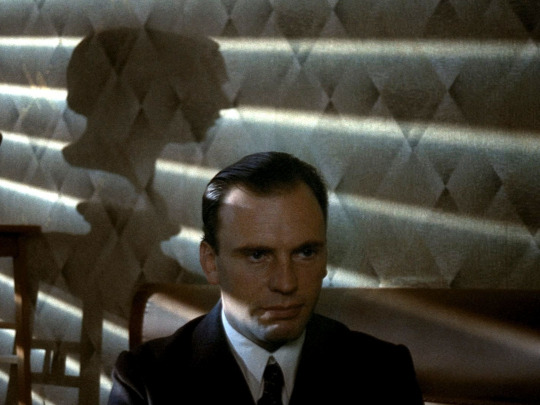
Jean-Louis Trintignant in The Conformist (Bernardo Bertolucci, 1970)
Cast: Jean-Louis Trintignant, Stefania Sandrelli, Gastone Moschin, Dominique Sanda, Enzo Tarascio, Fasco Giachetti, José Quaglio, Pierre Clémenti. Screenplay: Bernardo Bertolucci, based on a novel by Alberto Moravia. Cinematography: Vittorio Storaro. Production design: Ferdinando Scarfiotti. Film editing: Franco Arcalli. Music: Georges Delerue.
Of all the hyphenated Jeans, Jean-Louis Trintignant seems to me the most interesting. He doesn't have the lawless sex appeal of Jean-Paul Belmondo, and he didn't grow up on screen in Truffaut films like Jean-Pierre Léaud, but his career has been marked by exceptional performances of characters under great internal pressure. From the young husband cuckolded by Brigitte Bardot in And God Created Woman ... (Roger Vadim, 1956) and the mousy law student in whom Vittorio Gassman tries to instill some joie de vivre in Il Sorpasso (Dino Risi, 1962), through the dogged but eventually frustrated investigator in Z (Costa-Gavras, 1969) and the Catholic intellectual who spends a chaste night with a beautiful woman in My Night at Maud's (Eric Rohmer, 1969), to the guilt-ridden retired judge in Three Colors: Red (Krzysztof Kieslowski, 1994) and the duty-bound caregiver to an aged wife in Amour (Michael Haneke, 2012), Trintignant compiled more than 60 years of great performances. His most popular film, A Man and a Woman (Claude Lelouch, 1966), is probably his least characteristic role: a romantic lead as a race-car driver, opposite Anouk Aimée. His role in The Conformist, one of his best performances, is more typical: the severely repressed Fascist spy, Marcello Clerici, who is sent to assassinate his old anti-Fascist professor (Enzo Tarascio). Marcello's desire to be "normal" is rooted in his consciousness of having been born to wealth but to parents who have abused it to the point of decadence, with the result that he becomes a Fascist and marries a beautiful but vulgar bourgeoise (Stefania Sandrelli). Bertolucci's screenplay places a heavier emphasis on Marcello's repression of homosexual desire than does its source, a novel by Alberto Moravia. In both novel and film, the young Marcello is nearly raped by the chauffeur, Lino (Pierre Clémenti), whom Marcello shoots and then flees. But in the film, Lino survives to be discovered by Marcello years later on the streets the night of Mussolini's fall. Marcello, whose conformity does an about-face, sics the mob on Lino by pointing him out as a Fascist, and in the last scene we see him in the company of a young male prostitute. This equating of gayness with corruption is offensive and trite, but very much of its era. Even the sumptuous production -- cinematography by Vittorio Storaro, design by Ferdinando Scarfiotti, music by Georges Delerue -- doesn't overwhelm the presence of Trintignant's intensely repressed Marcello, with his stiff, abrupt movements and his tightly controlled stance and walk. If The Conformist is a great film, much of its greatness comes from Trintignant's performance.
6 notes
·
View notes
Photo

#the conformist#jean louis trintignant#stefania sandrelli#gastone moschin#dominique sanda#pierre clémenti#enzo tarascio#fosco giachetti#josé quaglio#bernardo bertolucci#1970
40 notes
·
View notes
Photo

Bernardo Bertolucci
- The Conformist / Il conformista
(1970)
#bernardo bertolucci#the conformist#il conformista#José Quaglio#jose quaglio#music#blind#darkness#1970#film#italian film#light#Vittorio Storaro
43 notes
·
View notes
Text
Il vaso

Insolito, assurdo (beh, questo aggettivo era scontato), divertente, il teatro di Ionesco. Dato che in genere sono colpito dai particolari e perdo di vista il Quadro Generale, qui vi dirò del vaso da notte scomparso.
Nella seconda scena de "La cantatrice calva", la cameriera Mary rientra a casa dopo aver passato il pomeriggio libero con un amico, andando al cinematografo e poi a bere qualcosa insieme a lui (acquavite e latte, ci informa Ionesco). Prima di aprire una porta e far entrare i signori Martin, che sono in anticamera, in attesa di cenare con la signora e il signor Smith, i padroni di casa, la fantesca recita:
MARY: éclate de rire. Puis, elle pleure. Elle sourit. Je me suis acheté un pot de chambre. (1)
Cioè:
Mary: (scoppia a ridere, poi piange. Sorride) Mi sono comprata un vaso da notte. (2)
L'accenno al vaso da notte, accessorio (immancabile?) nelle camere dei bisnonni, è però completamente scomparso dalla rappresentazione sceneggiata che ne fece la RAI nel 1967 (3), tratta dalla traduzione di Gian Renzo Morteo come riportato dai titoli di apertura, per il resto fedelissima al testo, e che si può rivedere interamente su YouTube. La sua battuta in TV, invece, è anodina:
Mary: Oggi ho comperato un cappello.
(1) E. Ionesco, La cantatrice chauve, [1950], Parigi, Gallimard, 1954 (2) E. Ionesco, La cantatrice calva in Teatro, vol. 1, Torino, Einaudi, 1976 [Trad. G. R. Morteo] (3) Regia di José Quaglio, con Franca Valeri, Ferruccio De Ceresa, Carmen Scarpitta, Renzo Montagnani, Gianni Bonagura e Serena Michelotti.
9 notes
·
View notes
Text

Questa Notte su Iris alle ore 02,40
Il Bellissimo Cult di Aldo Lado...
Sepolta viva
Data di uscita: 19 Ottobre 1973
Regista: Aldo Lado
Musiche Maestro Ennio Morricone
Paese di produzione: 🇮🇹 , 🇫🇷
Scritto da: Claudio Masenza, Antonio Troiso
Curiosità
il seguito di questo film uscì l’anno dopo (ambientato una ventina d'anni dopo) e si intitola Il figlio della sepolta viva diretto da Luciano Ercoli
Tratto dal romanzo di Marie Eugénie Saffray e sceneggiato, tra gli altri, dal critico Claudio Masenza, il film è un esempio di melodramma in costume, tornato prepotentemente di moda all'inizio degli anni Settanta.
Il film, ambientato nella Francia del diciannovesimo secolo, è stato girato al Castello di Fénis e di Issogne in Valle d'Aosta Cascate di Monte Gelato, Mazzano Romano
Cast
agostina.belli: Christine
Maurizio Bonuglia: Ferdinand
Fred Robsahm: Philippe
Laura Betti: Giovanna la pazza
José Quaglio: Morel
Dominique Darel: Dominique de Fontenoy
Monica Monet: Odette
Francis Perrin: Gael
Arturo Trina: Dany
Daniele Dublino: Abate
#sepolta viva#la sepolta viva#agostina belli#maurizio bonuglia#aldo lado#laura betti#giallo fever#spaghetti giallo#giallo movie#giallo italiano#giallo all’italiana#giallo films#giallofever#italian giallo#cine medioevo#cinemedioevo
9 notes
·
View notes
Text
Drame conjugal sur fond de lutte des classes, le film de Gilles Grangier contribue au renouvellement du registre de Gabin, deux ans après le succès de Touchez pas au grisbi. Adapté du roman magistral de Georges Simenon “Le Fils Cardinaud”, il livre un portrait sans concession d’une certaine bourgeoisie de province.
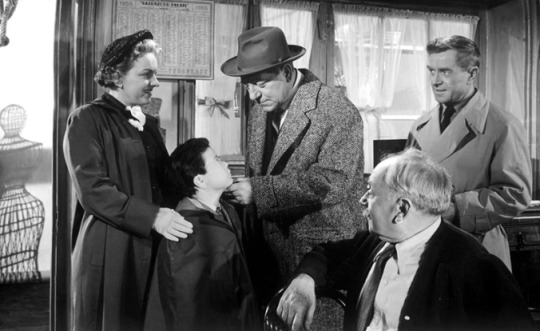
LE SANG À LA TÊTE – Gilles Grangier (1956) avec Jean Gabin, Renée Faure, Paul Frankeur, Monique Mélinand, Claude Sylvain, Henri Crémieux, Georgette Anys et José Quaglio
Il est toujours surprenant de constater comme un acteur peut se voir réduit à un certain type de rôles. Concernant le héros du Sang à la tête, il y aurait ainsi un Gabin d’avant-guerre abonné aux personnages de rebelles (La Bandera, Quai des Brumes, La Grande illusion… ). Puis, à partir des années 50, un dur à cuire inexorable, qu’il soit truand (Touchez pas au grisbi), policier (Maigret) ou capitaine d’industrie (Les Grandes familles).

LE SANG À LA TÊTE – Gilles Grangier (1956) avec Jean Gabin, Renée Faure, Paul Frankeur, Monique Mélinand, Claude Sylvain, Henri Crémieux, Georgette Anys et José Quaglio
Pourtant, si l’on considère ne serait-ce que les films de Gabin sortis en 1956, on constate à quel point sa palette était bien plus diversifiée. Sous la direction de Julien Duvivier, l’acteur commence par explorer le film noir avec Voici le temps des assassins, dans lequel il incarne le patron d’un restaurant parisien à la mode. Le Sang à la tête lui donne ensuite l’occasion de se couler dans la peau d’un armateur de La Rochelle, avant que Claude Autant-Lara ne s’amuse à casser l’image positive du comédien dans La Traversée de Paris : peintre qu’on qualifierait aujourd’hui d'”anar de droite”, Grandgil passe une partie du film à se répandre en ignominies, sur la nature humaine. Si le commissaire qu’incarne ensuite Gabin dans Crime et châtiment correspond davantage à ce que le public attend de lui, il n’en ira pas de même du médecin progressiste dépeint par Jean-Paul Le Chanois dans Le Cas du Docteur Laurent, film que l’acteur tourne à la fin de 1956. Mais une telle diversité ne peut sans doute résister au passage du temps, et ce sont les rôles les plus marquants de Gabin qu’ont aujourd’hui en tête les cinéphiles… [Collection Gabin – Eric Quéméré – mars 2006]
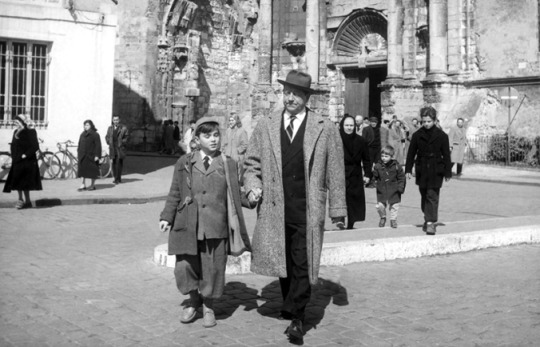
LE SANG À LA TÊTE – Gilles Grangier (1956) avec Jean Gabin, Renée Faure, Paul Frankeur, Monique Mélinand, Claude Sylvain, Henri Crémieux, Georgette Anys et José Quaglio
François Cardinaud est l’un des notables les plus influents de La Rochelle. Armateur, il règne en maître absolu sur le port, où son intransigeance lui vaut de nombreuses inimitiés. Mais en ce dimanche matin, c’est un problème d’ordre domestique qui le préoccupe : alors que toute la famille doit se rendre à la messe, Marthe, son épouse, reste introuvable. Une absence qui a peut-être à voir avec l’apparition dans le port d’un cargo venu d’Afrique…

Après La Marie du port et La Vérité sur Bébé Donge, Le Sang à la tête offre à Gabin une troisième incursion dans l’univers de Georges Simenon, cet écrivain qu’il apprécie tant. C’est également l’occasion pour l’acteur d’élargir encore un peu sa palette de personnages, en incarnant un “self-made man” qu’une indéniable réussite sociale n’a pas rendu plus heureux. Considéré comme un parvenu par ceux qui l’ont connu simple docker, François Cardinaud est tiraillé entre deux mondes, problématique à laquelle Gabin ne s’était pas encore réellement frotté. [Collection Gabin – Eric Quéméré – mars 2006]
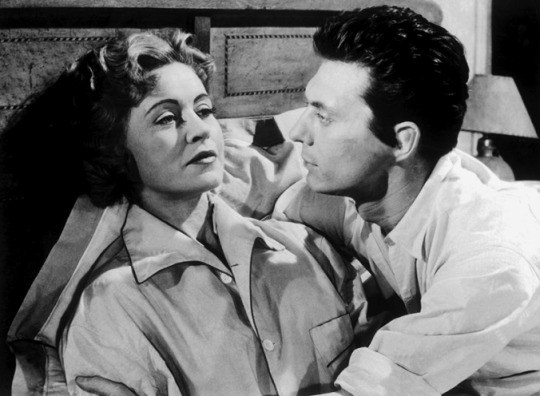
LE SANG À LA TÊTE – Gilles Grangier (1956) avec Jean Gabin, Renée Faure, Paul Frankeur, Monique Mélinand, Claude Sylvain, Henri Crémieux, Georgette Anys et José Quaglio
L’ambition sociale, confinant parfois à l’arrivisme, ne concerne d’ailleurs pas seulement son personnage, mais la plupart de ceux qui l’entourent : la gouvernante Mademoiselle, qui rêve d’un mariage d’argent ; les parents de Marthe, qui n’hésitent pas à mettre à contribution leur gendre ; et plus généralement, tous ceux qui, à La Rochelle, envient l’aisance de Cardinaud. Seule Marthe semble aspirer à autre chose que l’aisance matérielle – mais cette chose, son mari ne semble pas pouvoir la lui offrir…
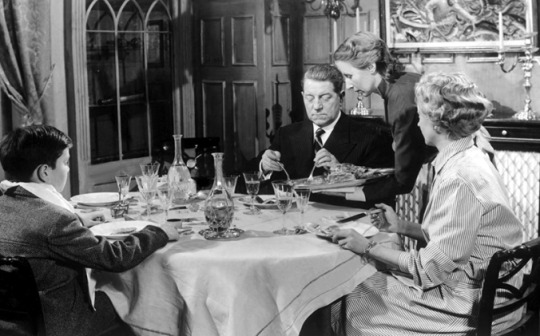
LE SANG À LA TÊTE – Gilles Grangier (1956) avec Jean Gabin, Renée Faure, Paul Frankeur, Monique Mélinand, Claude Sylvain, Henri Crémieux, Georgette Anys et José Quaglio
Le tournage du Sang à la tête débute le 15 février 1956, pour s’achever deux mois plus tard. Si les intérieurs sont filmés en studios à Paris, la plupart des extérieurs sont réellement tournés à La Rochelle. La présence sur le port d’une célébrité comme Jean Gabin fait évidemment sensation, mais grâce à la simplicité de l’acteur, qui s’est toujours refusé à jouer les stars, les rapports entre l’équipe et la population s’avèrent excellents. L’acteur, grand amoureux de la mer, apprécie de découvrir l’activité des quais, et de plaisanter avec les pêcheurs et les poissonniers. [Collection Gabin – Eric Quéméré – mars 2006]
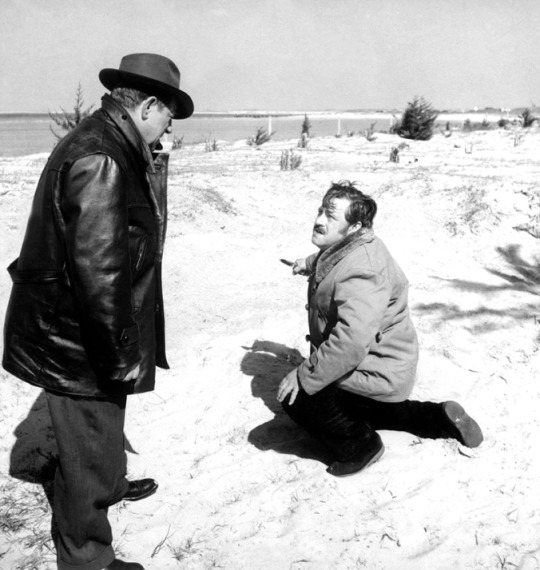
Nature à la ville comme à l’écran, droit dans ses bottes, l’acteur achève le film en toute sérénité, en compagnie d’une équipe ad hoc, dont l’assistant-réalisateur Jacques Deray qui fait aussi de la figuration – il campe Alfred le conducteur de car. Au contact du grand comédien, le futur réalisateur de Borsalino, en élève appliqué, prend de sérieuses leçons de cinéma : « C’était un seigneur, confie-t-il. Chaleureux mais pas très causant sur un plateau, il tirait son fauteuil à l’écart. Surtout pas de siège à côté de lui pour que personne ne vienne « l’emmerder”. Il était seul, et il regardait. On pensait qu’il était un peu indifférent à tout ce qui se passait autour de lui mais ce n’était pas vrai : il avait un œil, il observait. » Car les règles du cinéma français sont strictes, les horaires de travail coulés dans le bronze, de douze à dix-huit heures voire dix-neuf heures, six jours sur sept ; depuis longtemps rompu à ce rythme, Gabin n’a jamais failli : chaque jour, il débarque sur le plateau à midi “tête faite” c’est-à-dire maquillé et, selon sa propre expression “texte su” ! Quand ça ne tourne pas rond, il se met en colère, raison sans doute pour laquelle sur ce film, Grangier doit changer à quatre reprises de chef opérateur ; le premier, un Anglais, tombe malade, le second ne reste que huit jours, le troisième ne tient guère plus, c’est le quatrième qui achèvera le film. [Jean Gabin inconnu – Jean-Jacques Jelot-Bkanc – Ed. Flammarion (2014)]

LE SANG À LA TÊTE – Gilles Grangier (1956) avec Jean Gabin, Renée Faure, Paul Frankeur, Monique Mélinand, Claude Sylvain, Henri Crémieux, Georgette Anys et José Quaglio
Sur le plateau, Gabin prend également plaisir à donner la réplique à Renée Faure qui, dans le rôle de Mademoiselle, partage avec lui plusieurs scènes importantes. Après cette première collaboration réussie, les deux acteurs se retrouveront d’ailleurs pour deux autres films, Rue des prairies et Le Président. Après quelques semaines de montage Le sang à la tête sort à Paris le 10 août 1956. Si les résultats en salles ne seront pas comparables à ceux des grands succès connus par Gabin au cours des années 50, ils s’avèreront tout à fait honorables pour un film qui prend le risque de montrer l’acteur sous un jour moins glorieux que dans Touchez pas au grisbi ou French Cancan… [Collection Gabin – Eric Quéméré – mars 2006]

LE SANG À LA TÊTE – Gilles Grangier (1956) avec Jean Gabin, Renée Faure, Paul Frankeur, Monique Mélinand, Claude Sylvain, Henri Crémieux, Georgette Anys et José Quaglio
L’histoire
Ancien débardeur, François Cardinaud (Jean Gabin) est devenu, après trente ans de travail acharné, un armateur important de La Rochelle. Il a sauvé de la ruine Hubert (Henri Crémieux) et Charles Mandine (Léonce Corne), devenus ses associés. Ce dimanche-là, un cargo, L’Aquitaine, ramène Mimile Babin (José Quaglio), un garçon du pays qui n’a pas réussi à faire fortune en Afrique. Mimile retrouve sa sœur, Raymonde (Claude Sylvain), serveuse dans un café, et sa mère, Titine (Georgette Anys), marchande de poissons à la criée. Chez lui, Cardinaud attend que sa femme, Marthe (Monique Mélinand), revienne de la messe. Mais Marthe n’est toujours pas rentrée à l’heure du déjeuner. Inquiet, Cardinaud se rend chez ses beaux-parents, qui végètent dans un quartier pauvre de la ville. Ils ne peuvent le renseigner. Cardinaud va alors chez ses parents, des artisans vanniers, qui ne sont pas habitués à ses visites. Là non plus, aucune trace de Marthe. En ville, on murmure qu’elle a quitté le domicile conjugal pour de bon. La gouvernante des enfants, mademoiselle (Renée Faure), se voit déjà la nouvelle maîtresse de maison.
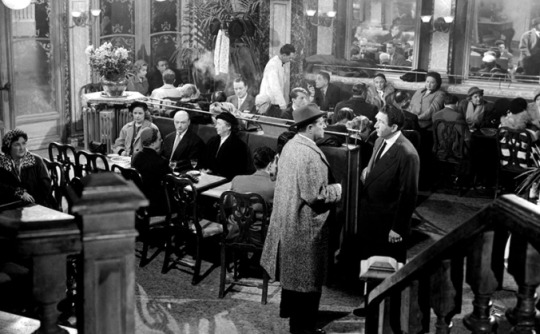
LE SANG À LA TÊTE – Gilles Grangier (1956) avec Jean Gabin, Renée Faure, Paul Frankeur, Monique Mélinand, Claude Sylvain, Henri Crémieux, Georgette Anys et José Quaglio
Deux jours plus tard, en l’absence de son mari, Marthe repasse chez elle, le temps de prendre une valise. Le soir, sur le port, Drouin (Paul Frankeur), capitaine de L’Aquitaine, apprend à Cardinaud que sa femme est partie avec Mimile Babin, son ancien amoureux. La ville est au courant, mais fait bloc contre l’armateur qu’on déteste à cause de sa réussite. Cardinaud arrache quelques renseignements à Raymonde et s’en prend publiquement à Titine Babin. Il retrouve la trace des amants dans un hôtel, mais arrive trop tard. De retour chez lui, Cardinaud y trouve son père, qui a reçu une lettre de Marthe expliquant qu’elle est mal à l’aise dans ce milieu de nouveaux riches. Se sentant délaissée par son mari, elle a besoin de renouer avec sa jeunesse. Cardinaud fait retirer sa licence à Titine Babin pour l’obliger à dire où est son fils. Il est dans l’île de Ré. Cardinaud prend le bac, mais il est suivi par Drouin, enragé contre Mimile qui l’a dénoncé à la douane. Les deux hommes en viennent aux mains, et Cardinaud assomme Drouin. Il arrive à l’auberge et y trouve Mimile, seul. Marthe est partie prendre le bac pour rentrer chez elle. Cardinaud réussit à la rejoindre et, sans un mot de reproche, revient avec elle à La Rochelle.
Les extraits
Fiche technique du film
Drame conjugal sur fond de lutte des classes, le film de Gilles Grangier contribue au renouvellement du registre de Gabin, deux ans après le succès de Touchez pas au grisbi. Adapté du roman magistral de Georges Simenon "Le Fils Cardinaud", il livre un portrait sans concession d'une certaine bourgeoisie de province. Drame conjugal sur fond de lutte des classes, le film de Gilles Grangier contribue au renouvellement du registre de…
2 notes
·
View notes
Text
Short Night of Glass Dolls (1971) (La Corta Notte delle Bambole di Vetro)

Directed by Aldo Lado
Written by Ernesto Gastaldi and Aldo Lado
Music by Ennio Morricone
Country: Italy, West Germany
Language: Italian
Running Time: 92 minutes
CAST
Ingrid Thulin as Jessica
Jean Sorel as Gregory Moore
Mario Adorf as Jacques Versain
Barbara Bach as Mira Svoboda
Fabijan Sovagovic as Professor Karting
José Quaglio as Valinski
Relja Basic as Ivan
Piero Vida as Kommissar Kierkoff
Daniele Dublino as Doctor

I’m sure someone would call Ado Lado’s directorial debut Short Night of the Glass Dolls a giallo, but that person wouldn’t be me. Sure, there’s certainly a case to be made: it is Italian, it is from the ‘70s, it has murders, it has a bizarre plot, it has a bittersweet Ennio Morricone soundtrack and it’s quite stylish in parts. Ultimately though, it’s not sleazy enough, not fetishistic enough and, cripplingly for a giallo, it actually has a serious point to make. Short Night of the Glass Dolls is more a ‘70s Italian thriller which seeks to voice a political opinion via metaphor. Don’t worry, it still has a body in a fridge and a creepy geriatric orgy, amongst other wonky delights. Short Night of the Glass Dolls is a good movie, one that’s achingly close to being a great movie. Alas, a soporific pace and a sustained failure to make the set pieces really pop undo it. Had it been a little artier or a little more ridiculous Short Night of the Glass Dolls would be a noteworthy movie, but as it sprawls between the two stools in an ungainly heap it remains more of an interesting footnote.

Short Night of the Glass Dolls begins winningly enough with the corpse of Gregory Moore (Jean Sorel; boring with a moustache) being found in a Prague plaza by a street cleaner. This is interesting since he is the hero. Gregory that is, not the street cleaner. Swiftly dispatched to the morgue it becomes apparent to the viewer (but to nobody else) that Gregory is still conscious but trapped inside his recalcitrant shell of meat. Given such an unenviable situation Gregory displays astounding self-control and mentally relives the events that brought him to this unfortunate pass, in an attempt to find a solution to his predicament before the coroner’s scalpel strikes, and he truly dies.

Everything seems to have begun when Gregory’s girlfriend, Mira Svoboda (Barbara Bach; yes, the Bond girl and Mrs Ringo Starr) mysteriously disappears in the nude and into the night, and his investigations soon reveal she is not the first pretty young thing to vanish starkers in the moonlight. Is there a conspiracy afoot? Are Gregory’s co-workers aiding him or abetting his enemies? Why are there so many blind people in Prague? Is it heavy handed symbolism? What’s with the butterflies? And who won’t let them dance? Or was it fly? Why isn’t burly, breast fondling, drunk Jacques (Mario Adorf ) the hero since he’s far more entertaining than deathly dull Greg? Questions. The questions come thick and fast and so do the threats, violence and eventually some very painful answers. And it’s to Short Night of the Glass Dolls’ great credit that the answers are worthy of the questions. However, that doesn’t mean they are to be taken literally. By the finale of Short Night of the Glass Dolls it should be clear to the most insensate audience that the movie has moved firmly into the allegorical.

Or would that shift actually be clear today? Probably not, unfortunately. Short Night of the Glass Dolls is a movie so very much of its time that it fails to explain a lot of things for modern audiences. It just assumes you will be aware of the then recent Soviet shenanigans centred on Prague. Basically, on August 20 1968, in an attempt to halt reform within Prague, the Soviet Union invaded Czechoslovakia. This attempt by the establishment to crush change is the thematic core of the movie. Its loss takes away much of Short Night of the Glass Dolls’ power. Because it is implicit that the Prague in which the movie is set is a repressive police state, where being a foreign journalist would be an extremely sensitive position. Actually, being a western journalist poking around in things the Soviet establishment would rather let lie would transcend the sensitive and verge on the suicidal. As students and feminists of the 1960s used to say, the personal is the political, and this is sure true for Short Night of the Glass Dolls. Gregory and Mira don’t spend much screen time together, but they spend most of it elliptically fretting about something; that something being the fact that Mira is a Soviet citizen and Gregory is not. Pretty much a recipe for disaster back then.

Basically, a lot of the jeopardy which would have infused every second of Short Night of the Glass Dolls for original viewers is regrettably absent for many modern viewers. The fact the police chief wears a leather overcoat and is sinisterly unhelpful would have been recognised in 1971 as being due to his apparatchik status rather than, in 2018, due to his apparently just being a bit of a dick. The real world Czech political context in 1971 also added weight to the message at the heart of the movie: the young will always want change and the old will always try to prevent this, at any cost. It’s a good message, but it seems a little nebulous when ripped from its original Cold War background. And the florid song of a street minstrel summing up the movie’s message in unsubtle couplets has aged as well as my hairline. Short Night of the Glass Dolls is a serious movie with serious themes, which also tries to entertain its audience; if it fails it’s mostly down to a failure to future-proof. But in 1971 that word didn’t exist and in 2018 nor does the USSR, so go figure. The real life Short Night of the Glass Dolls turned out to be even shorter than Aldo Lado could have ever hoped.

#short night of glass dolls#movies#italy#thriller#horror#1971#1970s#aldo lado#ennio morricone#barbara bach#jean sorel#mario adorf#west germany#la corta notte delle bambole di vetro#giallo
2 notes
·
View notes
Photo

The Conformist | Bernardo Bertolucci | 1970
Jean-Louis Trintignant, José Quaglio, et al.
79 notes
·
View notes
Photo


Il conformista Bernardo Bertolucci. 1970
Bridge Ponte Sant'Angelo, 00186 Rome, Italy See in map
See in imdb
Bonus: also in this location
#bernardo bertolucci#il conformista#jean-louis trintignant#josé quaglio#bridge#rome#lazio#italy#ponte sant'angelo#movie#cinema#film#location#google maps#street view#1970#bonus
30 notes
·
View notes
Text
28 febbraio … ricordiamo …
28 febbraio … ricordiamo … #semprevivineiricordi #nomidaricordare #personaggiimportanti #perfettamentechic
2017: Christine Kaufmann, Christine Maria Kaufmann, è stata un’attrice tedesca. Nel 1963, all’età di diciotto anni, sposò l’attore Tony Curtis. Ha pubblicato alcuni libri con consigli per la bellezza ed il benessere, oltre a due autobiografie. (n.1945) 2017: Leone Di Lernia, è stato un conduttore radiofonico, cantautore del genere trash-demenziale italiano. (n. 1938) 2016: George Kennedy, George…
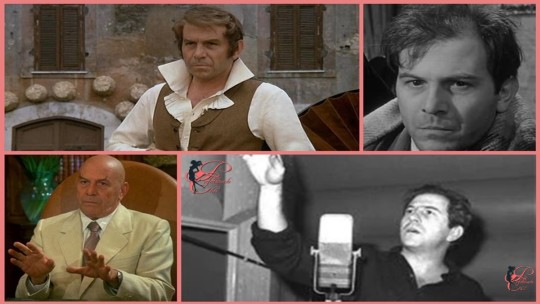
View On WordPress
#28 febbraio#Anna Sophie Ondráková#Annie Girardot#Anny Ondra#Cecil Kellaway#Christine Kaufmann#Christine Maria Kaufmann#Enrico Maria Salerno#Enrico Salerno#George Harris Kennedy#George Kennedy#Giuseppe Ferdinando Quaglio#Joan Greenwood#José Quaglio#Leone Di Lernia#morti 28 febbraio#Morti oggi#Philip Ahn#Pil Lip Ahn#Ricordiamo#Ruby Keeler#Zara Cully#Zara Cully Brown
2 notes
·
View notes
Text
28 febbraio … ricordiamo …
28 febbraio … ricordiamo … #semprevivineiricordi #nomidaricordare #personaggiimportanti #perfettamentechic #felicementechic #lynda
2017: Christine Kaufmann, Christine Maria Kaufmann, è stata un’attrice tedesca. Nel 1963, all’età di diciotto anni, sposò l’attore Tony Curtis. Ha pubblicato alcuni libri con consigli per la bellezza ed il benessere, oltre a due autobiografie. (n.1945) 2017: Leone Di Lernia, è stato un conduttore radiofonico, cantautore del genere trash-demenziale italiano. (n. 1938) 2016: George Kennedy, George…
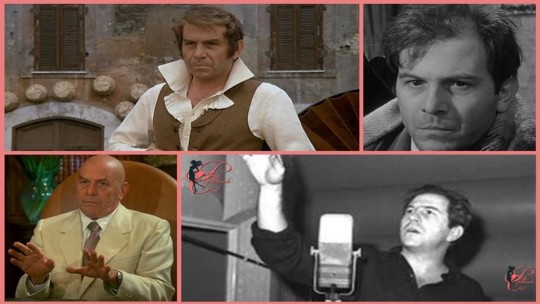
View On WordPress
#28 febbraio#Anna Sophie Ondráková#Annie Girardot#Anny Ondra#Cecil Kellaway#Christine Kaufmann#Christine Maria Kaufmann#Enrico Maria Salerno#Enrico Salerno#George Harris Kennedy#George Kennedy#Giuseppe Ferdinando Quaglio#Joan Greenwood#José Quaglio#Leone Di Lernia#morti 28 febbraio#Morti oggi#Philip Ahn#Pil Lip Ahn#Ricordiamo#Ruby Keeler#Zara Cully#Zara Cully Brown
0 notes
Text
28 febbraio … ricordiamo …
28 febbraio … ricordiamo … #semprevivineiricordi #nomidaricordare #personaggiimportanti #perfettamentechic #felicementechic #lynda
2017: Leone Di Lernia, è stato un conduttore radiofonico, cantautore del genere trash-demenziale italiano. Ha raggiunto la popolarità a inizio anni 1990 grazie a delle cover parodistiche e goliardiche di brani di musica dance. Era sposato con Rosa Nenna, ha avuto da lei quattro figli: Elena, Savino, Marco e Davide. È stato per quasi dieci anni (dal 1999 al 2008 e di nuovo, anche se parzialmente,…
View On WordPress
#28 febbraio#Anna Sophie Ondráková#Annie Girardot#Anny Ondra#Cecil Kellaway#Enrico Maria Salerno#Enrico Salerno#George Harris Kennedy#George Kennedy#Giuseppe Ferdinando Quaglio#Joan Greenwood#José Quaglio#Leone Di Lernia#morti 28 febbraio#Morti oggi#Philip Ahn#Pil Lip Ahn#Ricordiamo#Ruby Keeler#Zara Cully#Zara Cully Brown
0 notes
Text








1973
Sepolta viva
Also Known As (AKA)
(Alternative title) La sepolta viva
France (video title) La tour du désespoir
Greece (transliterated) Thammeni zontani
Portugal Sepultada Viva
Spain La sepultada viva
World-wide (English title) (informal literal title) Woman Buried Alive
Release Dates
Italy 19 October 1973 (Torino)
Portugal 14 September 1979 (Porto)
Directed by Aldo Lado
Music by Maestro Ennio Morricone
Writing Credits
Aldo Lado ... (screenplay)
Claudio Masenza ... (story screenplay)
Antonio Troiso ... (story screenplay) (as Antonio Troisio)
technical specifications
Runtime 1 hr 47 min (107 min)
Filming Locations
Monte Gelato Waterfall, Mazzano Romano, Lazio, Italy
Faleria, Viterbo, Lazio, Italy
Castello di Fénis, Aosta, Valle d'Aosta, Italy
Cast
Agostina Belli ... Christine
Maurizio Bonuglia ... Ferdinand
Fred Robsahm... Philippe
Laura Betti... Giovanna la Pazza
Dominique Darel ... Dominique de Fontenoy
Monica Monet... Odette
José Quaglio... Morel
Francis Perrin... Gael
Arturo Trina ... Dany
Daniele Dublino ... Abate
#sepolta viva#sepultada viva#la sepultada viva#aldo lado#agostina belli#maurizio bonuglia#laura betti#ennio morricone#giallo fever#giallofever#italian cult#cult#italian giallo#cinema cult#italian sexy comedy#gialli#giallo#international cult
4 notes
·
View notes
Text










1973
Sepolta viva
Also Known As (AKA)
(Alternative title) La sepolta viva
France (video title) La tour du désespoir
Greece (transliterated) Thammeni zontani
Portugal Sepultada Viva
Spain La sepultada viva
World-wide (English title) (informal literal title) Woman Buried Alive
Release Dates
Italy 19 October 1973 (Torino)
Portugal 14 September 1979 (Porto)
Directed by Aldo Lado
Music by Maestro Ennio Morricone
Writing Credits
Aldo Lado ... (screenplay)
Claudio Masenza ... (story screenplay)
Antonio Troiso ... (story screenplay) (as Antonio Troisio)
technical specifications
Runtime 1 hr 47 min (107 min)
Filming Locations
Monte Gelato Waterfall, Mazzano Romano, Lazio, Italy
Faleria, Viterbo, Lazio, Italy
Castello di Fénis, Aosta, Valle d'Aosta, Italy
Cast
Agostina Belli ... Christine
Maurizio Bonuglia ... Ferdinand
Fred Robsahm... Philippe
Laura Betti... Giovanna la Pazza
Dominique Darel ... Dominique de Fontenoy
Monica Monet... Odette
José Quaglio... Morel
Francis Perrin... Gael
Arturo Trina ... Dany
Daniele Dublino ... Abate
#sepolta viva#sepultada viva#la sepultada viva#aldo lado#agostina belli#maurizio bonuglia#laura betti#ennio morricone#giallo fever#giallofever#italian cult#italian giallo#cult#cinema cult#gialli#italian sexy comedy#giallo#international cult
4 notes
·
View notes
Text










1973
Sepolta viva
Also Known As (AKA)
(Alternative title) La sepolta viva
France (video title) La tour du désespoir
Greece (transliterated) Thammeni zontani
Portugal Sepultada Viva
Spain La sepultada viva
World-wide (English title) (informal literal title) Woman Buried Alive
Release Dates
Italy 19 October 1973 (Torino)
Portugal 14 September 1979 (Porto)
Directed by Aldo Lado
Music by Maestro Ennio Morricone
Writing Credits
Aldo Lado ... (screenplay)
Claudio Masenza ... (story screenplay)
Antonio Troiso ... (story screenplay) (as Antonio Troisio)
technical specifications
Runtime 1 hr 47 min (107 min)
Filming Locations
Monte Gelato Waterfall, Mazzano Romano, Lazio, Italy
Faleria, Viterbo, Lazio, Italy
Castello di Fénis, Aosta, Valle d'Aosta, Italy
Cast
Agostina Belli ... Christine
Maurizio Bonuglia ... Ferdinand
Fred Robsahm... Philippe
Laura Betti... Giovanna la Pazza
Dominique Darel ... Dominique de Fontenoy
Monica Monet... Odette
José Quaglio... Morel
Francis Perrin... Gael
Arturo Trina ... Dany
Daniele Dublino ... Abate
#sepolta viva#sepultada viva#la sepultada viva#aldo lado#agostina belli#maurizio bonuglia#laura betti#ennio morricone#giallo fever#italian giallo#giallofever#cult#italian cult#cinema cult#italian sexy comedy#gialli#international cult#giallo
3 notes
·
View notes